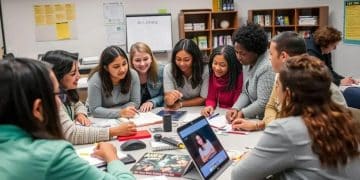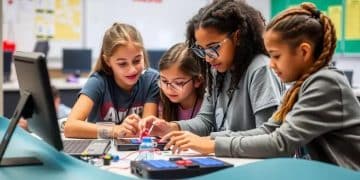Early literacy programs in underserved areas boost futures
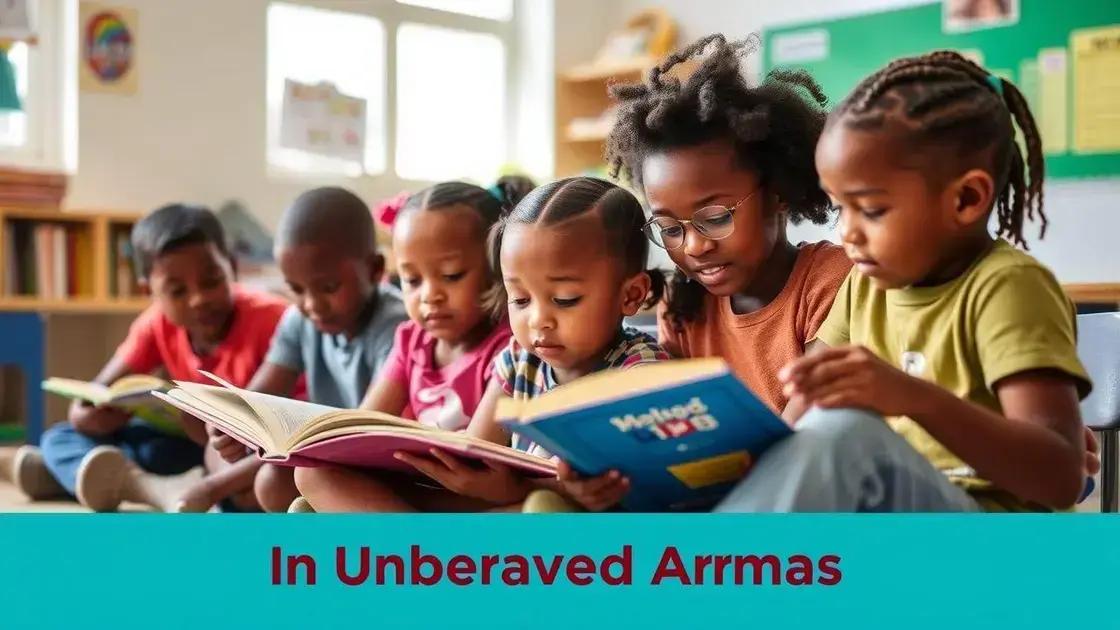
Early literacy programs in underserved areas are essential initiatives that develop reading and writing skills, fostering community engagement and supporting families to ensure children have the tools necessary for academic success.
Early literacy programs in underserved areas are crucial in transforming the educational landscape. Have you ever considered how these initiatives shape the futures of children? In this article, we’ll delve into their significance and explore effective strategies to enhance literacy where it’s needed most.
Understanding the importance of early literacy
Understanding the significance of early literacy is the first step toward creating a brighter future for children. In many underserved areas, access to resources and educational support is limited. Early literacy programs can bridge this gap and pave the way for lifelong learning.
The Role of Early Literacy in Development
When children engage with books and language early on, they develop critical skills. These skills include phonemic awareness and vocabulary, which are the building blocks of reading. Early literacy helps children express themselves confidently.
Benefits of Strong Early Literacy Programs
Implementing effective programs leads to impressive outcomes, including:
- Improved reading scores among children
- Higher levels of engagement in school
- Enhanced social skills as kids learn to communicate
- Greater likelihood of educational success and job readiness
Additionally, these programs foster a love for reading. Children who enjoy reading often perform better academically. They tend to explore different subjects and become well-rounded individuals.
Investing in early literacy is not just beneficial for individuals; it strengthens entire communities. When literacy rates rise, so does overall community health, economic growth, and social cohesion.
Challenges in Implementation
While there are many advantages, challenges exist in implementing effective literacy programs. Some of these challenges include a lack of funding, insufficient training for educators, and minimal community involvement. Addressing these hurdles is crucial.
Success stories exist where communities have rallied together to tackle these issues. By engaging local stakeholders, schools can create tailored programs that meet the specific needs of their populations.
Through collaborative efforts, communities can create robust early literacy initiatives that empower children and lay the groundwork for future success.
Challenges faced in underserved areas
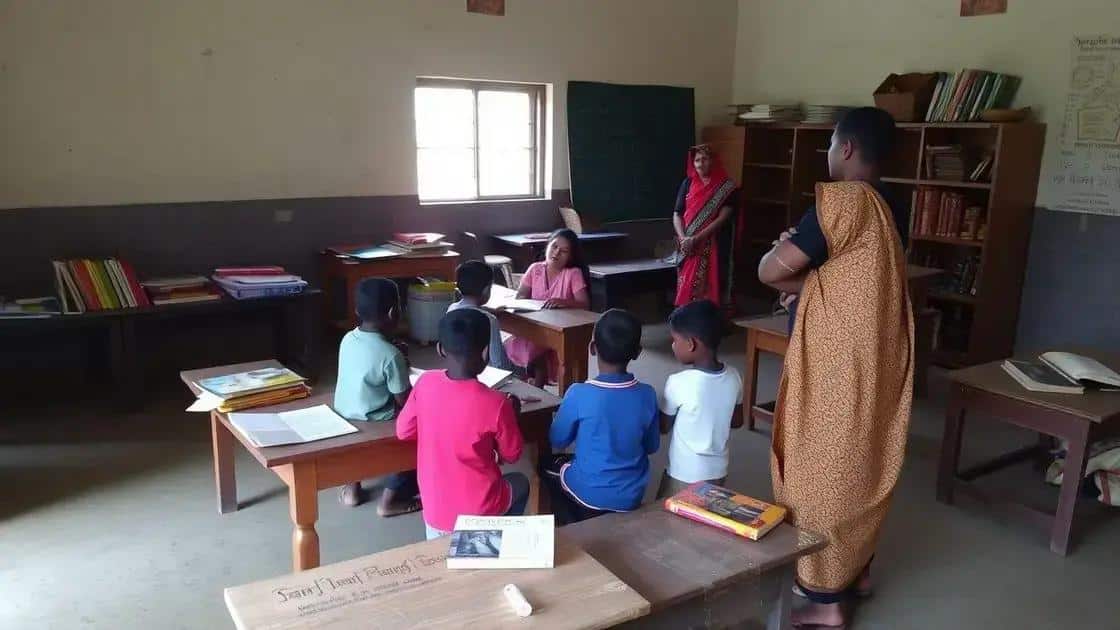
In many communities, accessing quality education presents serious challenges. Underserved areas struggle with inadequate resources that can hinder early literacy programs. Understanding these obstacles is crucial to creating effective solutions.
Lack of Resources and Funding
One major issue is the lack of financial support for educational initiatives. Schools often operate with limited budgets, making it difficult to acquire necessary materials such as books and technology. This scarcity directly affects the quality of literacy programs.
Limited Access to Trained Educators
Another challenge is finding qualified early literacy educators. Many teachers in underserved areas may not receive the specialized training needed to implement effective programs. Their expertise is vital for fostering student engagement and developing necessary skills.
- Inconsistent professional development opportunities
- High teacher turnover rates
- Inadequate support from school districts
Furthermore, low student-to-teacher ratios can place additional strain on instructors, limiting their ability to provide personalized guidance.
Community Engagement and Support
Building community support for literacy initiatives is often difficult. Many families in underserved areas face challenges such as economic instability and lack of transportation, which can prevent them from participating in educational programs. To combat this, programs must actively seek ways to involve families.
Creating partnerships with local organizations can help strengthen community ties. When families feel more connected to the educational process, they are more likely to engage with literacy programs.
Addressing these challenges requires collaboration among schools, communities, and policymakers. Together, they can forge solutions that improve educational access and outcomes for children in underserved areas.
Successful case studies of literacy programs
Successful literacy programs can serve as powerful examples for others. These programs demonstrate what is possible when communities invest in early literacy initiatives. By examining several case studies, we can identify key strategies that have yielded positive results.
Case Study: A Community Partnership
One notable example comes from a community in the Midwest, where local organizations banded together to launch a literacy program. They created a comprehensive approach, combining after-school tutoring with family engagement activities. Parents received training on how to support their children’s reading at home.
- Increased student reading levels
- Higher parent involvement in schools
- Improved community-wide attitudes toward education
This collaborative effort helped solidify the importance of early literacy in the community. It also illustrated the power of local partnerships in overcoming resource constraints.
Case Study: Innovative Use of Technology
Another inspiring case is found in a rural district that embraced technology to enhance literacy. They introduced a digital platform where students could access e-books and engaging reading activities. The program included training for teachers and workshops for families.
As a result, children showed remarkable improvement in their reading skills. The program reported:
- 30% increase in reading scores
- Greater enthusiasm for reading among students
- Expansion of resources accessible to families
This case highlights how leveraging technology can address gaps in traditional resources. Underserved areas can benefit significantly from innovative solutions that keep learners motivated.
By sharing these success stories, we can encourage other communities to develop similar early literacy programs that are tailored to their unique needs. These examples prove that with creativity, collaboration, and commitment, positive change is not only possible but achievable.
Strategies for promoting literacy outreach
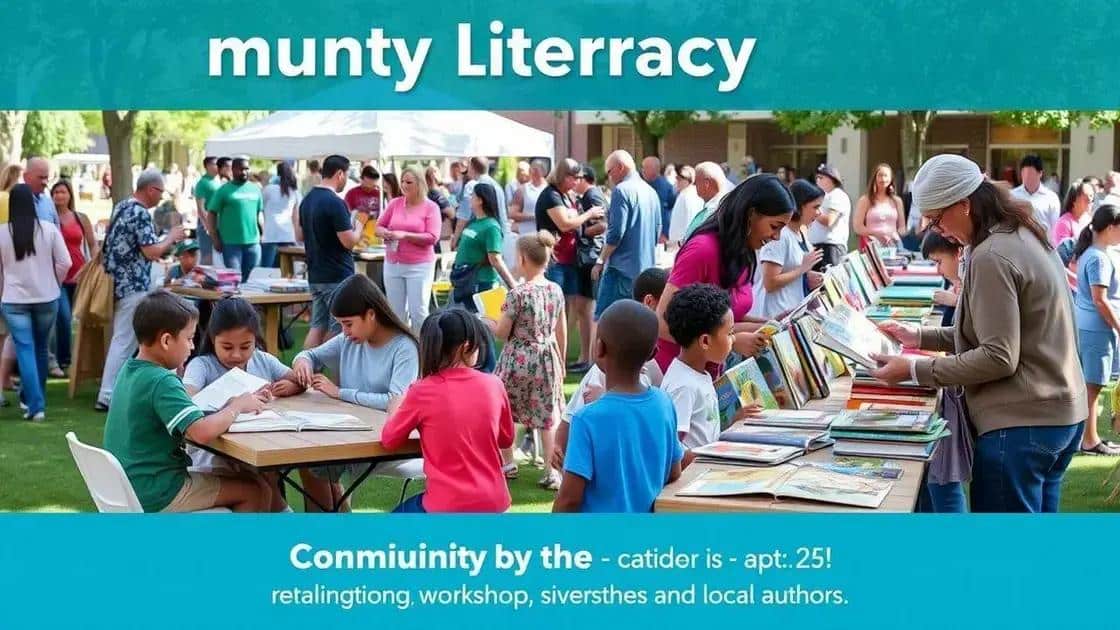
Promoting literacy outreach is vital for ensuring that children in underserved areas have access to quality education. Various strategies can be implemented to enhance these initiatives, making a significant difference in communities. Fostering a culture of reading begins by recognizing the community’s unique needs.
Building Community Partnerships
One effective strategy is to build strong partnerships within the community. Collaboration among schools, libraries, and local organizations can strengthen literacy programs. These partnerships can lead to:
- Sharing resources and best practices
- Co-hosting events that engage families
- Creating a supportive network for educators and volunteers
- Increasing access to books and educational materials
When community members come together, they can create a robust support system that nurtures literacy development.
Organizing Reading Events
Organizing community reading events can ignite interest in books and reading. Events like read-aloud sessions, book fairs, and literacy nights can draw families together. They promote engagement and show the importance of literacy. Here are some effective ideas:
- Host a “Family Reading Night” with activities for all ages
- Invite local authors for book signings and discussions
- Provide free books to children during events
Such activities not only promote reading but also help build community bonds among families.
Offering training sessions for parents on how to support their children’s reading at home can also be beneficial. When families are equipped with the right tools, they can play a key role in their child’s literacy journey. Utilizing simple techniques such as shared reading can make a huge impact.
Acknowledging and celebrating the achievements of students can further motivate them. Recognitions, such as reading challenges or certificates for progress, can encourage children to engage more with literacy programs.
These strategies together form a comprehensive approach to promoting literacy outreach. By empowering communities and fostering a love for reading, we can transform the future of children in underserved areas.
Promoting literacy outreach is essential for creating a brighter future for children in underserved areas. By building strong community partnerships, organizing engaging events, and supporting families, we can foster a love for reading. These strategies help ensure that every child has access to the tools they need to succeed. With dedication and collaboration, we can make a lasting impact on literacy and education in our communities.
FAQ – Frequently Asked Questions about Early Literacy Programs
What are early literacy programs?
Early literacy programs are educational initiatives focused on developing reading and writing skills in young children, particularly in underserved areas.
Why are community partnerships important for literacy outreach?
Community partnerships enhance resources, support, and engagement, making literacy programs more effective and impactful for families.
How can parents support their children’s literacy at home?
Parents can promote literacy by reading with their children, creating a reading-friendly environment, and encouraging storytelling and writing activities.
What impact do reading events have on communities?
Reading events foster a love for books, build community connections, and engage families in the educational process, which is crucial for young learners.



